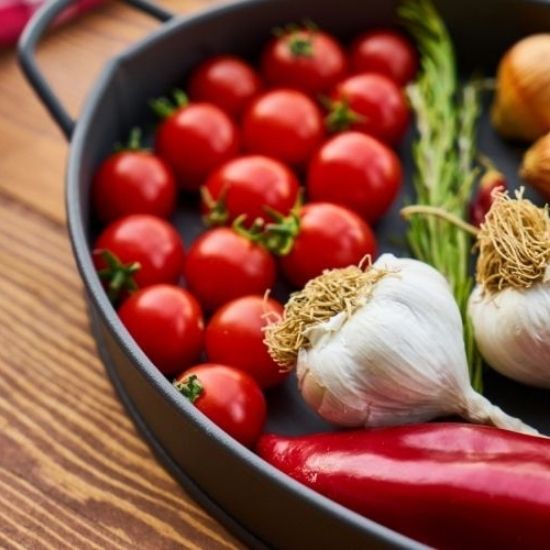News & Tips

Here you find info about the products, Greek or Mediterranean cuisine, and diet tips.
Stay up to date!!
Greek saffron

Greek saffron
Saffron comes from the Crocus flower and grows in Northern Greece, in the region of Kozani. Saffron is a delicious spice, which although many people know in recent years, seems to have been known since antiquity! It is said that Cleopatra was the one who saw its importance for cosmetic use and Aeschylus as a way to dye fabrics. In modern times, saffron is used in cooking, cosmetics, dyeing, pharmaceuticals.
According to mythology
It is said that Crocus was a friend of the god Hermes. One day, while the two friends were playing, Hermes accidentally hit his friend and he died. At the spot where Crocus died, a flower grew. Three drops of Crocus' blood fell on the flower and these became the stigmata of the flower. Since then, the flower is called Crocus and the stigmata, saffron.
According to Homer's Iliad, Homer referred to the saffron with the following words: "The Sunrise drew her crocus-like scarf over the sea to bring light to Gods and men alike."
It also seems that the ancient Minoans cultivated saffron during the Late Bronze Age in Crete. However, afterwards the cultivation disappeared from Greece.
Cultivation
Saffron is mainly used in cooking, pharmaceutical, and cosmetic industries all around the world. The countries of Iran and Spain also produce saffron, but Greek saffron is considered the best in the world. It is scientifically called "Crocus Sativus Linneaus".
During the 17th century, the production of saffron came to the area of Kozani, by Greek Macedonian traders, who brought the plant from Austria. Climatic and soil conditions made the area ideal and have allowed the cultivation of saffron for the last 300 years or so. Now the annual production is about 1.2 to 2 tons.
Harvest
The flower harvest begins around mid-October. All harvesting is done by hand, as the use of a spade or tractor is strictly forbidden. The stigmas (saffron) are then taken from the flower and dried carefully so that they do not lose any of their properties. After drying, the stigmas reach 1/5 of their original size. As a result, from 1 kg of raw stigmas, we get 200 gr. of saffron ready for consumption.
Autumn is the best time to visit Krokochoria (= the villages of Crocus/Krokos) and see the saffron harvesting process.
Mediterranean Diet

Mediterranean Diet by Greenolia
The Mediterranean diet expresses a holistic lifestyle approach. It is all about quality food, social interaction, proper exercise and life outdoors, in the sunlight. The Mediterranean diet is rightfully considered one of the healthiest on the planet. For thousands of years, the inhabitants of the Mediterranean coast combined light and tasty meals with intense physical activity.
The Mediterranean diet is based on ingredients of natural origin and therefore meets our needs in basic nutrients. The food categories included in the Mediterranean nutrition pyramid for every meal make our daily diet nutritionally complete and balanced. Most of the ingredients are fresh, therefore seasonal, and the meals are easy to prepare. Fried food, saturated fat, sodium, sweets and meat have limited presence in the pyramid. The basic natural foods to be included are: vegetables, fruit, pulses, whole meal cereals, dried nuts, olives, olive oil, cheese, yogurt, fish, poultry, eggs and wine. Those food categories are at the base of the nutrition plan and provide us with thousands of microminerals, antioxidants, vitamins, minerals and fibers that “work” together in order to protect us from chronic diseases.
More specifically, the Mediterranean diet suggests:
Daily:
- Cereals and cereal-based products (rice, pasta, bread, etc.). Low in fat, they provide energy. They promote intestinal health and decrease cholesterol levels.
- Fruit and vegetables. A good source of antioxidants and multiple vitamins. They protect us from cardiovascular conditions and various forms of cancer.
- Pulses and dried nuts. Extremely rich in plant fibers and vitamins. Body energy suppliers.
- Olive Oil. Rich in antioxidants and mono-unsaturated fatty acids. It is considered the basis of the mediterranean diet. It protects us from coronary heart disease, as it decreases “bad” cholesterol (LDL) levels.
- Dairy products. An excellent source of calcium. They help keep bone mass at high levels.
A few times a week:
- Fish. They contain omega3 fatty acids.
- Poultry. They provide us with proteins of high nutritional value and iron.
- Eggs. Rich in proteins, vitamins and minerals.
- Sweets. They supply the human body with simple carbs. They provide immediately usable energy.
A few times a month:
Meat. It contains valuable proteins, iron and vitamins.
Benefits
A number of studies continue to prove that the consumption of food that is rich in fibers and healthy fat, benefits and creates a protective shield for our organism. According to tests, those who adopt the mediterranean diet are protected from:
- heart conditions (by keeping triglycerides, blood sugar and arterial pressure to normal levels)
- metabolic syndrome
- certain forms of cancer
- obesity
- type 2 diabetes
- dementia or Alzheimer’s






